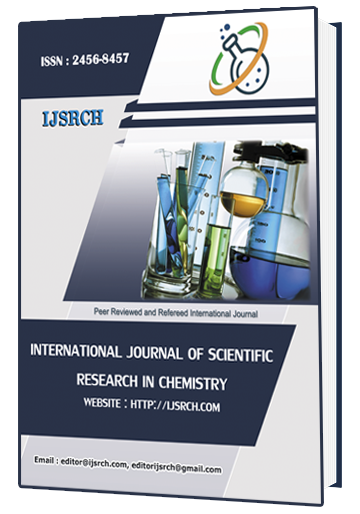Eco-Friendly Synthesis and Physicochemical Characterization of Silver Nanoparticles Mediated by Eugenia roxburghii DC. Extract with Antibiofilm Efficacy against Pathogenic Bacteria
DOI:
https://doi.org/10.32628/IJSRCH2495350Keywords:
Silver Nanoparticles, Eugenia Roxburghii, Green Synthesis, Antibacterial Activity, Biofilm Inhibition, NanotechnologyAbstract
The increasing resistance of bacteria to conventional antibiotics necessitates the exploration of alternative antimicrobial strategies. This study presents a green, eco-friendly synthesis of silver nanoparticles (AgNPs) using methanolic leaf extract of Eugenia roxburghii DC., a medicinal plant known for its rich phytochemical content. The synthesized AgNPs were characterized by UV–Visible spectroscopy, X-ray diffraction (XRD), high-resolution transmission electron microscopy (HR-TEM), and zeta potential analysis. A distinct surface plasmon resonance peak at 417 nm confirmed nanoparticle formation, while XRD and HR-TEM analyses revealed a crystalline, predominantly spherical morphology with an average particle size of 24–35 nm. The AgNPs exhibited strong antibacterial activity, particularly against Staphylococcus aureus, as demonstrated by disc diffusion and minimum inhibitory concentration (MIC) assays. Furthermore, the nanoparticles significantly inhibited biofilm formation, as observed on Congo Red Agar plates. These findings underscore the potential of E. roxburghii-mediated AgNPs as a sustainable and biocompatible alternative for combating pathogenic bacteria and biofilm-related infections. Future in vivo and toxicological studies are warranted to evaluate clinical applicability.
References
Ahmed, S., Ahmad, M., Swami, B. L., & Ikram, S. (2016). A review on plants extract mediated synthesis of silver nanoparticles for antimicrobial applications: A green expertise. Journal of Advanced Research, 7(1), 17–28. https://doi.org/10.1016/j.jare.2015.02.007
Barros, C. H. N., Fulaz, S., Stanisic, D., & Tasic, L. (2018). Biogenic nanosilver against multidrug-resistant bacteria (MDRB). Nanomaterials, 8(2), 93. https://doi.org/10.3390/nano8020093
Costerton, J. W., Stewart, P. S., & Greenberg, E. P. (1999). Bacterial biofilms: A common cause of persistent infections. Science, 284(5418), 1318–1322. https://doi.org/10.1126/science.284.5418.1318
Das, S., Behera, S., & Acharya, L. (2022). Antimicrobial potential of Eugenia roxburghii leaf extract: A preliminary study. International Journal of Pharmaceutical Sciences and Research, 13(7), 3002–3007.
Das, S., Behera, S., & Acharya, L. (2022). Antimicrobial potential of Eugenia roxburghii leaf extract: A preliminary study. International Journal of Pharmaceutical Sciences and Research, 13(7), 3002–3007.
Dash, M., Sahoo, D., & Pattanayak, S. (2020). Medicinal importance of Myrtaceae family with special emphasis on Eugenia species. Journal of Pharmacognosy and Phytochemistry, 9(5), 2046–2050.
Donlan, R. M., & Costerton, J. W. (2002). Biofilms: Survival mechanisms of clinically relevant microorganisms. Clinical Microbiology Reviews, 15(2), 167–193. https://doi.org/10.1128/CMR.15.2.167-193.2002
Fernandes, A. R., Sampaio, A., Freitas, F., Carvalho, M. L., & Pereira, E. (2020). Phytochemical-assisted synthesis of silver nanoparticles from Eugenia uniflora L. extract and their antibacterial activity. Materials Today: Proceedings, 31, S143–S148. https://doi.org/10.1016/j.matpr.2020.05.420
Hoiby, N., Bjarnsholt, T., Givskov, M., Molin, S., & Ciofu, O. (2010). Antibiotic resistance of bacterial biofilms. International Journal of Antimicrobial Agents, 35(4), 322–332. https://doi.org/10.1016/j.ijantimicag.2009.12.011
Iravani, S. (2011). Green synthesis of metal nanoparticles using plants. Green Chemistry, 13(10), 2638–2650. https://doi.org/10.1039/c1gc15386b
Khan, Z., Al-Thabaiti, S. A., Obaid, A. Y., & Khan, Z. A. (2019). Green synthesis of silver nanoparticles using plant extracts and their antimicrobial activities: A review. Green Processing and Synthesis, 8(1), 57–70. https://doi.org/10.1515/gps-2018-0043
Loo, Y. Y., Rukayadi, Y., Nor-Khaizura, M. A. R., Kuan, C. H., Chieng, B. W., Nishibuchi, M., & Radu, S. (2018). In vitro antimicrobial activity of green synthesized silver nanoparticles against selected Gram-negative foodborne pathogens. Frontiers in Microbiology, 9, 1555. https://doi.org/10.3389/fmicb.2018.01555
Pereira, J. A., Oliveira, I., Sousa, A., Ferreira, I. C. F. R., Bento, A., & Estevinho, L. (2012). Bioactive properties and chemical composition of six wild edible Eugenia species from Brazil. Food Chemistry, 131(3), 849–856. https://doi.org/10.1016/j.foodchem.2011.09.068
Prasad, K. S., Pathak, D., Patel, A., Dalwadi, P., Prasad, R. S., Patel, P., & Selvaraj, K. (2021). Phyto-assisted synthesis of silver nanoparticles using Eugenia caryophyllata and their antibacterial activity. Scientific Reports, 11, 10925. https://doi.org/10.1038/s41598-021-90492-2
Rai, M., Yadav, A., & Gade, A. (2009). Silver nanoparticles as a new generation of antimicrobials. Biotechnology Advances, 27(1), 76–83.
Giri, A. K., Jena, B., Biswal, B., Pradhan, A. K., Arakha, M., Acharya, S., & Acharya, L. (2022). Green synthesis and characterization of silver nanoparticles using Eugenia roxburghii DC. extract and activity against biofilm-producing bacteria. Scientific Reports, 12(1), 8383.
Pugazhenthi, E., Sankarganesh, P., Muthusamy, C., Rajasekaran, M., Lokesh, E., Khusro, A., & Kavya, G. (2024). Cleome rutidosperma leaf extract mediated biosynthesis of silver nanoparticles and anti-candidal, anti-biofilm, anti-cancer, and molecular docking analysis. Biomass Conversion and Biorefinery, 14(22), 28971-28983.





